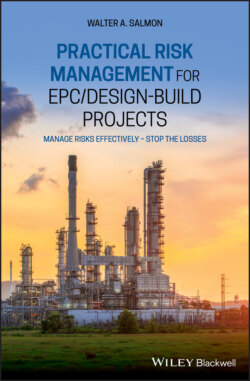Читать книгу Practical Risk Management for EPC / Design-Build Projects - Walter A. Salmon - Страница 44
3.10 Allocating Responsibility for Handling Risks
ОглавлениеI have seen a steady movement over the past decade or so to change the perception of Project Risk Management away from it being the simple application of common sense and more to it being an intricate management system that can only be applied by consultants who are specialised in the field. Perhaps this is because, as Professor John Adams has observed, it is not only that the word ‘risk’ ‘engenders a sense of urgency because it alludes to the probability of adverse, sometimes catastrophic, outcomes’,12 but also, as he adds: ‘people are using the same word, to refer to different things, and shouting past each other’.13 I have found that this trend has added some confusion about whose responsibility risk management is within a typical construction company. Consequently, this has been detrimental to the adoption by Contractors of a cohesive approach to implementing Project Risk Management, other than in respect of where physical (manual) work is involved (such as, for example, HSE matters, commissioning activities, etc.). Nowadays (I am very pleased to see), hands-on specialists/professionals in those particular fields (not pure risk management specialists) are engaged to manage the very real and ever-present day-to-day risks involved in such activities.
In order for a Manager to be held responsible for managing all the risks involved in his/her Department's work, he/she must first understand precisely what those particular risks are. However, I have rarely seen specific training given to Managers as to where the major risks relevant to their respective Departments sit. Without boundary limits for risk management being provided, the area of risk to be managed by Managers can appear to be very wide, and much more than the average Manager would be able to handle. That is probably a major reason why a good number of the Department Managers I worked with genuinely believed that the ‘upper’ management levels of their corporation were responsible for taking care of all the risks involved in the business. What was not well understood, as I discovered through questioning various Managers, is that, as Martin Lipton has stated, the Board of Directors ‘cannot and should not be involved in actual day-to-day risk management’,14 and ‘Directors should instead, through their risk oversight role, satisfy themselves that the risk management policies and procedures designed and implemented by the company's senior executives and risk managers are consistent with the company's strategy and risk appetite … that necessary steps are taken to foster an enterprise-wide culture that supports appropriate risk awareness … and that ensures that risk-taking beyond the company's determined risk appetite is recognized and appropriately escalated …’15
It is therefore not surprising that I also found that a common misperception of the Managers I spoke to was that all they are required to do is ensure that others under their control ‘get on with doing the Project work properly’, which Hayday's findings seem to corroborate.16 That wrong view about who is responsible for managing the risks of doing the day job is probably the main reason why the interfaces between the different Departments are often not handled effectively. I am certain that, if they are honest with themselves, most Managers would acknowledge that they are aware of instances where they themselves failed to deal with some risks properly (particularly with inter-Departmental interfaces), which then resulted in avoidable (and thus personally embarrassing) delays occurring and/or rework becoming necessary.
